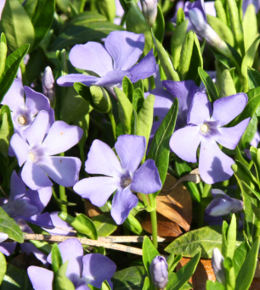Vinca plant is a favorite among plant growers as it loves heat. Come sunshine and you will find your plant flourish. Let us have a look at some related information.

Vinca plant, call it periwinkle if you like, will forever remain a hot favorite among gardeners. You can grow it directly in the soil out in the open or in a container. The vinca belongs to the family
Apocynaceae. You should not confuse this periwinkle with
Catharanthus, that shares this common name.
Catharanthus is an annual plant, whereas, vinca is evergreen (only one species of the 5 is deciduous). It is native to Europe, southwest Asia, and northwest Africa.
Description
Vinca is a herbaceous shrub that grows to a height of 3 to 6 inches. It produces flat, white or pink flowers, that grow all year round. The fruit is a dry dehiscent fruit and seeds are released from one site of rupture. The leaves are broad and evergreen in four species. However, the leaves of
Vinca herbacea are deciduous. These plants suffer from dieback in the winter season.
Species
There are five species of the plant.
- Vinca rosea
- Vinca difformis
- Vinca major
- Vinca minor
- Vinca herbacea
Most species of the plant are perennial and require minimum watering and plenty of sun. If you live in a warm region, it will survive the winter season. The most commonly cultivated species are the evergreen ornamental plants of
vinca major and
vinca minor. The former is aggressive and invasive in nature. It has large, heart-shaped leaves and is known as 'big leaf periwinkle'. It is often grown in areas to prevent soil erosion and as garden edging. Vinca minor is also known as ground myrtle. It has smaller leaves as well as flowers. The leaves are blue-green in color and flowers are purple or lilac-blue.
Care
It is very easy to care for this plant. You need to grow the plant in an area that receives full sun to partial shade. It will grown in average soil. It is heat and drought-resistant, thus making it popular in regions that have a hot, dry climate. You need to plant it in moist soil with a pH of 6 to 7. It needs well-drained soil as it does not like stagnant water. Space each plant about a foot apart and water it once or twice a week. Fertilize it once a month. You can use a water-soluble 20-20-20 mix fertilizer and cover it with foliage. Mulching will help retain moisture and prevent weeds from growing around the plant.
Diseases
Some of the common diseases that affect the plant include fungal diseases like canker, aerial blight, and black root rot. Other fungal diseases include fusarium wilt and fungal leaf spots. Vinca minor plant is usually affected with stem blight, botrytis blight, and canker. If you spot these fungal diseases, it is important that you immediately prune the affected part. There are many fungicides for black root rot and canker. Discard the pruned parts as the infection can spread around the garden. Most of these fungal diseases spread in overly moist conditions; therefore, avoid overhead irrigation.
Vinca plants are generally used as borders, edging, and bedding plants. Vinca vines are generally used for ground cover. The plants are heat-tolerant and will smile upon your garden in summers when other flowers wilt and die.






 Vinca plant, call it periwinkle if you like, will forever remain a hot favorite among gardeners. You can grow it directly in the soil out in the open or in a container. The vinca belongs to the family Apocynaceae. You should not confuse this periwinkle with Catharanthus, that shares this common name. Catharanthus is an annual plant, whereas, vinca is evergreen (only one species of the 5 is deciduous). It is native to Europe, southwest Asia, and northwest Africa.
Vinca plant, call it periwinkle if you like, will forever remain a hot favorite among gardeners. You can grow it directly in the soil out in the open or in a container. The vinca belongs to the family Apocynaceae. You should not confuse this periwinkle with Catharanthus, that shares this common name. Catharanthus is an annual plant, whereas, vinca is evergreen (only one species of the 5 is deciduous). It is native to Europe, southwest Asia, and northwest Africa.